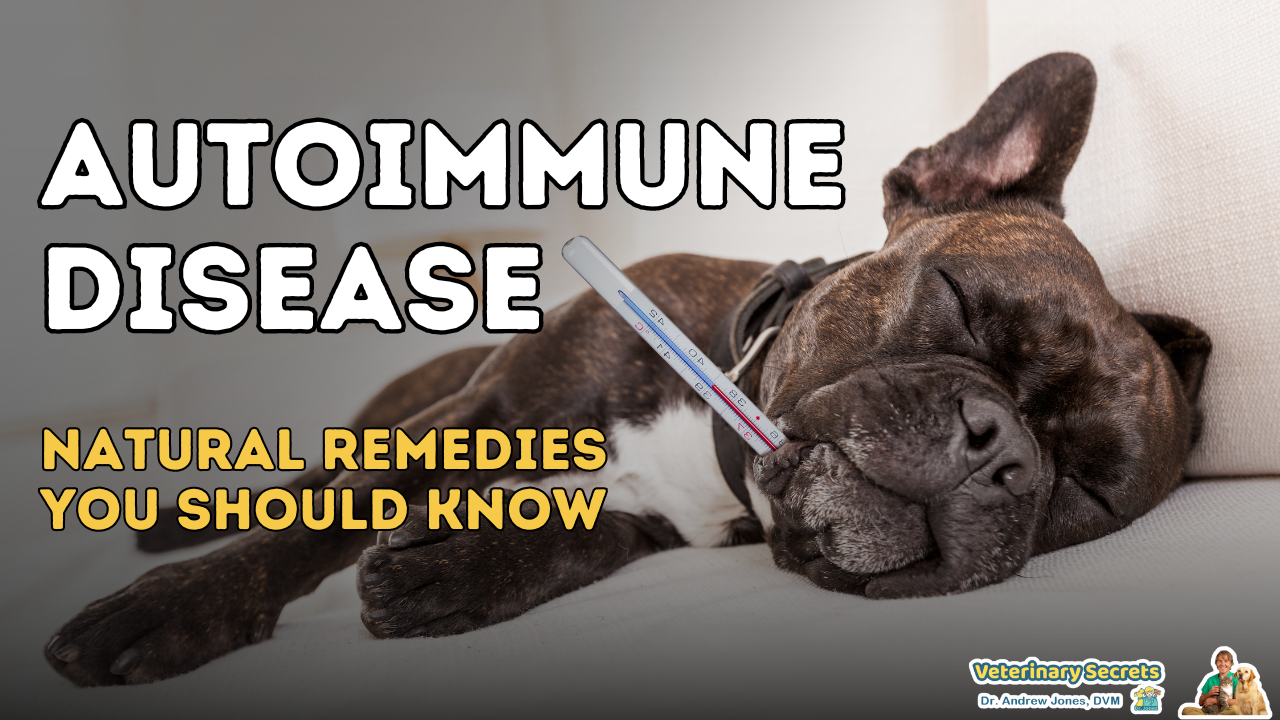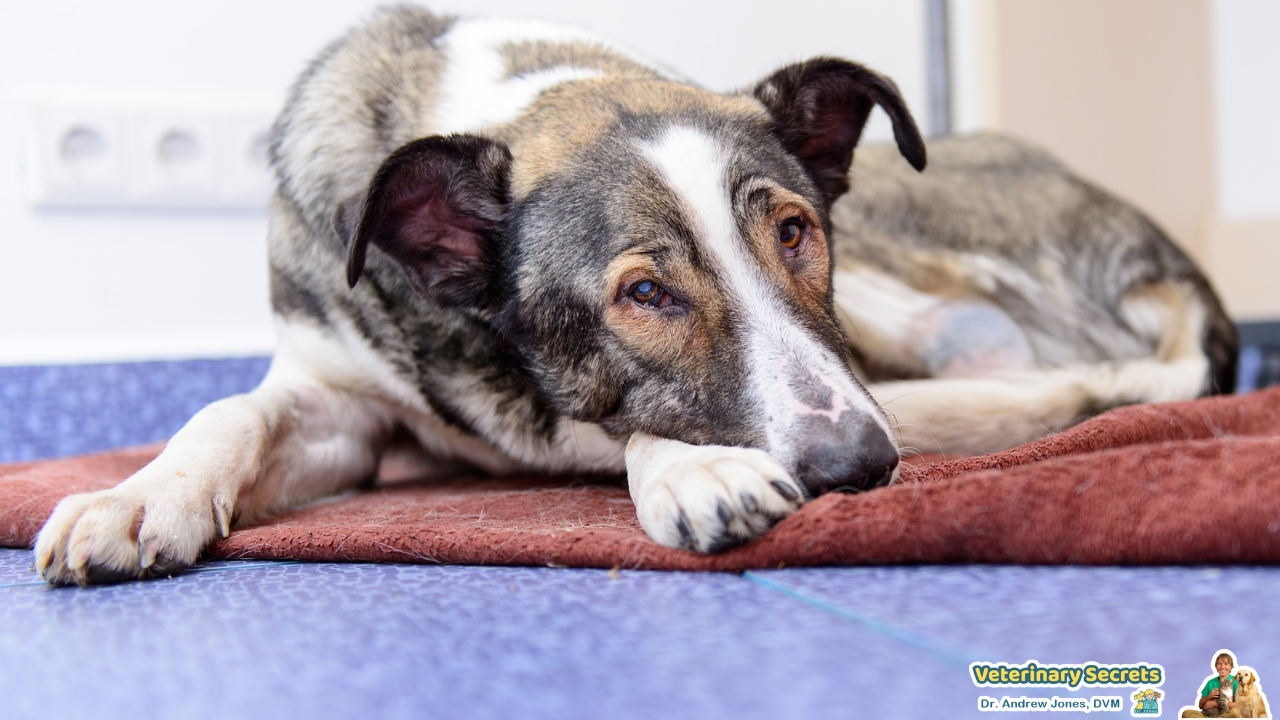Holistic Approach for Dogs with Autoimmune Diseases: What You Need to Know

Hypothyroidism, Allergies, Diabetes : these and so many of our dog and cat diseases have an autoimmune basis to them. In other words, your pet’s immune system is attacking itself.
Most of the conventional veterinary options are to suppress this overactive immune response, and NOT get to the underlying cause.
Many pet parents have had success with holistic products, and in particular the medicinal ingredients in the cannabis plant, especially CBD.
I do have a Natural, Whole Plant Extract CBD tincture for Dogs and Cats
It’s here:
Dr Jones’ ULTIMATE CBD for Dogs and Cats


Autoimmune disease covers a broad variety of disorders in pets that affect the immune system.
A dog’s/cats’ immune system is a network of white blood cells, antibodies, and other defenses in the body that fight off infections and foreign substances, including bacteria and viruses. Autoimmune diseases cause the immune system to attack the body’s own cells and tissue.
Some of the common conditions include these:
- AIHA (Immune mediated hemolytic anemia)
- ITP (thrombocytopenia)
- Polyarthritis
- Systemic Lupus, Discoid Lupus
- Hypothyroidism
- Allergies
- Diabetes Mellitus (Type 1 and 2)
Conventional Veterinary Medicine offers few options.
Prednisone and other corticosteroids are the primary options, but come with a host of side effects.(Increased drinking, urination, eating, Cushings disease, Diabetes, immunosuppression)
Stronger immunosuppressives (ie chemotherapeutics such as cyclophosphamide) work, but come with even more side effects. Side effects include hair loss or changes in hair coat. More serious side effects include decreases in blood cell counts that may appear as infections, bleeding, or bruising, lack of appetite, vomiting, and diarrhea, blood in the urine, depression, lung damage, difficulty breathing, dizziness, seizures, or tremors.
HOLISTIC OPTIONS
- GREEN TEA – Green tea is a product of the dried leaves of Camellia sinensis and is used for treatment of autoimmune diseases, such as immune mediated polyarthritis. The catechin present in green tea possesses anti-inflammatory properties. The Green Tea EXTRACT in capsules is easiest to give, and provided the highest levels of EGCG. A typical dog dose is 1mg/lb twice daily.
- LICORICE ROOT EXTRACT – LICORICE known as (Glycyrrhiza glabra) has shown immune-modulatory properties. It is used extensively for allergies, and is considered a ‘natural’ corticosteroid. Glycyrrhizin and glycyhrritinic acid are the active constituents which have antiinflammatory effects by inhibition of calcineurin activity and T-cell proliferation. Licorice Root dose for immune modulation is 1mg/lb twice daily- in a standard tincture bottle this would be 1/2ml per 20lbs twice daily. The alcohol tincture free tinctures may be better. If alcohol based, 1st add to hot water, evaporate the alcohol, then give.
- ARTEMISININ – ARTEMISININ has been extensively used for the treatment of autoimmune diseases such as systemic lupus and rheumatoid arthritis. Artemesinin as well as its derivatives artesunate and artemether possess immune-modulatory effect. It is also known as ‘ Sweet Wormwood’, but has been documented for its use in Chinese Medicine thousands of years ago. A combination product called Artemix is favored by many holistic veterinarians- it contains artemisinin, artesunate and artemether. The dose is typically 1 milligram of per kg body weight per day. (2mg/lb). It is best to give it 3-4 hours after feeding to get best absorption.
- REHMANNIA – This Chinese herb has shown promise in bringing balance to aggressive autoimmune states. Studies have shown that this herb possesses both immune-enhancing and immune-suppressant effects. Animal studies have shown it to be very safe with few side effects. A dog and cat starting dose of the tincture is 2mg/lb twice a day. A typical tincture dose is 1/4ml per 20lbs twice daily.
- CBD (Cannabidiol) as a ‘natural’ immune modulator. CBD has been studied for it’s effects as an immune modulator… One study found that ‘CBD suppressed several immunological endpoints…Specifically, CBD suppressed cytokine production. CBD exhibits immunosuppressive properties. In particular, CBD decreased IL-8 and the chemokines MIP-1? and MIP-1? from a human B cell line… ‘ CBD should be considered if you have a dog or cat with an autoimmune disease. Dog and Cat starting dose is 3mg/10lbs twice daily.
P.S. I recently cracked a rib, and after trying strong conventional pain killers, muscle relaxants, I found I was getting far longer sustained pain control from the CBD. I started using it topically as well (with DMSO), and together that has worked very well for me.
P.P.S. If you have a dog or cat with an autoimmune disease (or a pet in pain), you should consider cannabidiol (CBD).
It is a whole plant extract meaning it has all the potentially helping cannabinoids that interact with each other to be beneficial, as well as using hemp seed oil as the carrier oil (often this can make it more effective)
You can get your bottle here:

Where do you buy these remedies?
Hi Rosanne you can find Dr. Jones’ CBD here:
https://shop.veterinarysecrets.com/supplements/ultimate-cbd.html
I have a Yorkie diagnosedwith GME
It’s in the spinal Column. Is there anything holistic that could help. Maybe detoxing or the CBD?
Yes CBD is useful on neurological diseases and another supplement we suggest for progressive inflammatory disease is our Ultimate BioActive Quercetin.
Check it here:
https://shop.veterinarysecrets.com/supplements/dr-jones-ultimate-bioactive-quercetin.html
https://shop.veterinarysecrets.com/supplements/ultimate-cbd.html
What do you recommend for a dog with Masticatory Muscle Myositis with swollen lymph nodes? Thank you!
Here’s an article that can help:
Dogs – Lymphoma in Dogs (Conventional Veterinary Medicine)
The “typical” canine lymphoma patient is a middle-aged dog brought to the veterinarian because one or more lumps have been found. The veterinarian rapidly determines that all of the peripheral lymph nodes (those near the skin surface) are enlarged and firm. Usually the dog has not been showing any signs of illness. The next step is a blood panel and urinalysis to more completely assess the patient’s health and one or more lymph nodes are aspirated or biopsied to confirm the diagnosis of lymphoma.
So here we are. We have confirmed lymphoma and we know the average life expectancy for a patient with untreated lymphoma is about 2 months from the time of diagnosis. If this is your dog you probably need some time to absorb the import of the cancer diagnosis. You have many general questions and you know that a decision regarding chemotherapy must be rendered.
We will attempt to cover commonly asked questions owners have at this point.
How did my dog get lymphoma?
We do not know how dogs (or people for that matter) get cancer most of the time. There are many types of cancer and many possible causes of cancer (chemicals in our environment, sun exposure, assorted viruses and infections). There are important genetic factors as well. Cancer starts with one or a small group of cells that have “gone wrong.” It appears that such cells arise in our bodies all the time and we have an assortment of natural mechanisms to destroy these cells before they get out of hand. Sometimes these cancer cells escape our natural mechanisms and cancer develops. It is important to realize that cancer is not contagious and that, as a pet owner, you should not feel that you caused this or brought it on your pet somehow.
Many people feel a need to find blame and latch onto the idea that a household cleaner or pesticide was the cause. This is a natural part of grieving but it is important not to focus on cause unduly. Cause is not relevant to treatment; further, there is no way to verify cause. It is best to concentrate on treatment. At this time, there is no way to know what caused lymphoma development in a given patient.
Can my dog be cured?
Theoretically, yes, but practically speaking no. It is best to focus on a realistic outcome which is the longest possible survival with good quality life. Different treatment protocols are associated with different disease-free intervals.
Does my pet need further tests?
If a biopsy has not been performed, it is a good idea to have one done so as to gain the maximum information about the tumor (whether it is slow or fast growing, what type of lymphocytes are involved etc.) as this information can help predict the response to chemotherapy. In cats, due to the effects of the feline leukemia virus on the bone marrow, a biopsy is absolutely necessary to diagnose lymphoma as there are many other blood diseases that can mimic lymphoma. In the dog, however, a lymph node aspirate is frequently adequate to make the lymphoma diagnosis. Many oncologists will require a biopsy prior to referral.
Other tests that may be recommended include a bone marrow aspirate and/or a spleen or liver aspirate. These tests are needed to stage the disease. Lymphoma is classified by stage:
Stage I: – only one lymph node involved
Stage II: – several lymph nodes in the same general area involved
Stage III: – all peripheral lymph nodes involved
Stage IV: – all peripheral lymph nodes plus the spleen, liver, and/or anterior mediastinum in the chest involved
Stage V: – everything in stage IV plus bone marrow involvement
In cases of lymphoma that are not as straightforward as the classical multicentric lymphoma described above, staging may be more important. Staging used to be done regularly after the initial diagnosis of lymphoma but it has since been found that stage of disease does not impact upon the response to chemotherapy (i.e., it is not true that a stage II will have a better response than a stage IV). The exception is Stage V, the most advanced stage. Patients with stage V lymphoma tend to have a poor response to chemotherapy.
How does lymphoma cause death?
Lymphoma is a rapidly growing malignancy that is able to go and grow anywhere where there is lymph tissue. This is virtually every organ in the body. Eventually, the cancer will infiltrate an organ to such an extent that that organ fails (often this is the bone marrow or the liver). The patient loses his/her appetite, vomits or gets diarrhea, weakens and dies. At some point the tumor becomes resistant to therapy and no further remissions can be obtained.
My dog does not fit the above scenario at all. What are other forms of lymphoma?
Lymphoma is classifed by anatomic area affected. By far, the most common form in the dog is the multicentric form as described above. There are other forms:
* Skin form (also called mycosis fungoides)
* Gastrointestinal form (affecting only the GI tract)
* Leukemia (bone marrow form)
Lymphoma can occur anywhere in the body where there is lymph tissue. At this time, I will concentrate on multicentric lymphoma.
Chemotherapy
The word chemotherapy conjours images of the bald Elizabeth Perkins from The Doctor or the bald and vomiting Campbell Scott in Dying Young. It is unfortunate that many pets (and probably people, too) do not receive chemotherapy based upon these unpleasant images that do not truly represent the current state of treatment response. Chemotherapy simply means therapy using medication, as opposed to therapy using surgery or radiation. We hope that you will open your mind to what decades of research and clinical experience tells us about chemotherapy rather than listening to what Hollywood has to say on the subject. The following are common questions pet owners commonly have regarding chemotherapy for their dog.
My dog is not acting sick in any way. Shouldn’t I wait until she at least feels sick before beginning chemotherapy?
This might seem like a reasonable approach at first glance but let us assure you that it really isn’t. One of the most important factors in determining the quality of remission (i.e., how fast we get remission and how long it lasts) is whether or not the patient is feeling sick at the time chemotherapy is started. When lymphoma patients are staged (see above under “does my pet need further tests”), stages are subcategorized as “a” or “b” (for example, a multicentric lymphoma dog who feels well is in stage IIIa while a multicentric lymphoma dog who is vomiting or not eating is in stage IIIb). You will have a much better chance for long term quality survival if lymphoma is treated while the patient is an “a.”
Should we see an oncologist?
It is never wrong to see a specialist. Lymphoma is such a common malignancy in humans that there are always new drugs, new protocols and experimental therapy that your regular veterinarian may not be familiar with. Seeing a specialist may be the best way to present you with all of your options. If you are interested, ask your veterinarian for a referral.
Will chemotherapy make my dog sick?
Probably not. Nausea or infection are possibilities but most dogs do not experience any such complications. Only 7% of patients require hospitalization due to side effects of chemotherapy. The bottom line here is to know that animals rarely get sick from chemotherapy but that you should know what to do in case of a problem (see later)
Will chemotherapy make my dog lose his hair or go bald?
While whiskers are commonly lost, substantial hair loss is not experienced by animals on chemotherapy for cancer. There are some notable exceptions: breeds that have synchronous hair follicle activity. Most breeds have hairs in all diffferent stages of the growth-shed cycle at the same time. A few breeds have all hairs in the same stage of growth-shed at the same time. The breeds that can have a baldness issue include: the Olde English Sheepdog, the poodle, the lhasa apso, the shih tzu.
How will I know when we have achieved remission?
A patient in remission is indistinguishable from a completely cancer-free patient. The lymph nodes will go down to normal size and if there were any signs of illness related to the cancer, these should resolve. There is approximately a 75% chance of achieving remission regardless of protocol selected.
How will I know when we have lost remission?
The most obvious sign will be that the lymph node enlargement has returned. This means that the cancer is now resistant to the drugs being used and new drugs must be chosen. (This is called a rescue.)
How long will my dog have quality life on chemotherapy?
This depends on what protocol you choose and there are many. There are also many factors that influence how an individual will do relative to the “average” response. Important parameters to note when reviewing a protocol are: 1) the disease-free interval (i.e., how long the patient is free from illness); 2) survival time; 3) typical duration of remission; 4) expense; and 5) scheduling.
Protocols and Studies
Chemotherapy followed by half-body radiation therapy for canine lymphoma: Williams, L.E., Johnson, J.L., Hauck, M.L. Ruslander, D.M., Price, G., and Thrall, D.E. Journal of the American College of Veterinary Internal Medicine. Sept/Oct 2004; 18: 703-709
Half-body radiation involves irradiating the front of the dog’s body two days in a row, waiting 3 weeks, and then irradiating the rear half of the dog’s body for two days in a row. In this study 94 dogs with lymphoma received an 11 week chemotherapy induction using prednisone, L-asparaginase, vincristine, doxorubicin, and cyclophosphamide. Of the 94 dogs receiving chemotherapy, 78% (73 dogs) achieved remission. Of these 73 dogs, 52 underwent half-body radiation as above. Only dogs that had achieved remission were allowed to have radiation. The median remission time for these 52 dogs was 311 days. Thirty-one of these 52 dogs lost remission during the time of the study and twenty of them repeated chemotherapy induction, followed by maintenance chemotherapy (without more radiation). Seventeen out of twenty were able to achieve a second remission. It is not entirely clear whether or not this protocol increased the median remission duration over more routine chemotherapy but the relatively short (11 week) chemotherapy protocol may provide substantial convenience factor for an owner. Another important advantage was the fact that 85% of dog seeking a second remission were able to obtain one. The disadvantage of this protocol is the expense of radiation and the fact that the necessary equipment may not be readily available.
My dog is diabetic. She has had a wound on her left limb for 3 years. Different stages of awful. A biopsy indicated she has trichoepithelioma, neutrophilic and lymphoplasmascytic dermatitis with edema. She has a wound on the left limb for 3 years. She has had 3 surgeries, multiple
rounds of antibiotics, and anti inflammatory meds and still unresolved. Which of your products would you recommend to deal with this issue? Since it was explained to me that she has an autoimmune disease, I would like to try one of the cannabis products.
We do have supplements for you that you can choose from, check it out here:
https://shop.veterinarysecrets.com/supplements/digestive-health.html